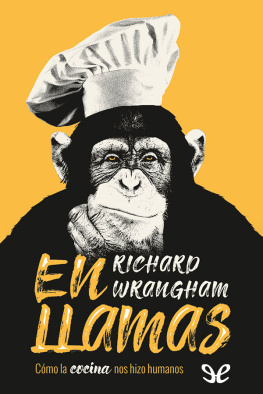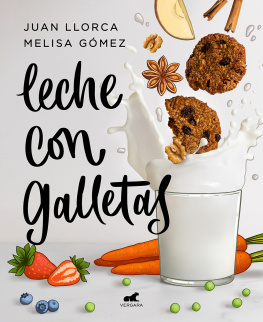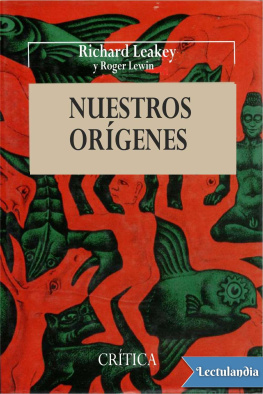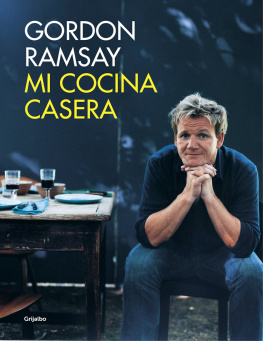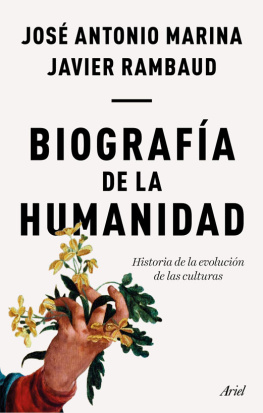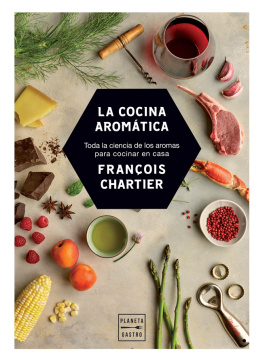Agradecimientos
E stoy en deuda con muchas fuentes, amigos y colegas que han guiado mis intentos de entender la importancia de la cocina. Agradezco especialmente a Rachel Carmody, Nancy Lou Conklin-Brittain, Jamie Jones, Greg Laden y David Pilbeam su colaboración en la investigación. Quiero expresar mi gratitud en particular a quienes me ofrecieron asesoramiento editorial y académico en versiones anteriores. Dale Peterson, el difunto Harry Foster, Martin Muller, Elizabeth Ross y Bill Frucht me regalaron con generosidad sus comentarios detallados. Rachel Carmody, Felipe Fernández-Armesto, Elizabeth Marshall Thomas, Victoria Ling, Anne McGuire, David Pilbeam y Bill Zimmerman tuvieron asimismo la amabilidad de leer borradores enteros. Por sus comentarios sobre capítulos concretos, doy las gracias a Robert Hinde, Kevin Hunt, Geoffrey Livesey, Bill McGrew, Shannon Novak, Lars Rodseth, Kate Ross, Stephen Secor, Melissa Emery Thompson y Brian Wood. Por otro tipo de apoyos, ideas y consejos, quiero expresar mi agradecimiento a Leslie Aiello, Ofer Bar-Yosef, Dusha Bateson, Pat Bateson, Joyce Benenson, Jennifer Brand-Miller, Alan Briggs, Michelle Brown, Terry Burnham, Eudald Carbonell, John Coleman, Matthew Collins, Randy Collura, Debby Cox, Meg Crofoot, Roman Devivo, Irven DeVore, Nancy DeVore, Nate Dominy, Katie Duncan, Peter Ellison, Rob Foley, Scott Fruhan, Dan Gilbert, Luke Glowacki, Naama Goren-Inbar, John Gowlett, Peter Gray, Barbara Haber, Karen Hardy, Brian Hare, Jack Harris, Marc Hauser, Kristen Hawkes, Sarah Hlubik, Carole Hooven, Sarah Hrdy, Stephen Hugh-Jones, Kevin Hunt, Dom Johnson, Doug Jones, Sonya Kahlenberg, Ted Kawecki, Meike Kohler, Kat Koops, Marta Lahr, Mark Leighton, Dan Lieberman, Susan Lipson, Julia Lloyd, Peter Lucas, Meg Lynch, Zarin Machanda, Bob Martin, Chase Masters, el difunto Ernst Mayr, Rob McCarthy, Rose McDermott, Eric Miller, Christina Mulligan, Osbjorn Pearson, Alexander Pullen, Steven Pyne, Eric Rayman, Philip Rightmire, Neil Roach, Diane Rosenberg, Lorna Rosen, Norm Rosen, Kate Ross, Stephen Secor, Diana Sherry, Riley Sinder, Catherine Smith, Barb Smuts, Antje Spors, Michael Steiper, Nina Strohminger, Michael Symons, Mike Wilson, Tory Wobber, Brian Wood y Kate Wrangham-Briggs. Por el excepcional apoyo institucional, deseo expresar mi reconocimiento al difunto Jeremy Knowles, a Doug Melton y a David Pilbeam. Por la oportunidad de escribir con tranquilidad, doy las gracias a los trabajadores de la Biblioteca Pública de Weston (Massachusetts), a Alison y Kenneth Ross (Badachro, Escocia), a Robert Foley y Marta Lahr (Centro Leverhulme de Estudios de la Evolución Humana, Cambridge, Reino Unido), a la Biblioteca Médica de la Universidad de Cambridge (Reino Unido) y a las autoridades del Parque Nacional de Kibale, en Uganda, donde escribí la propuesta de este libro durante tres semanas a la sombra de una higuera en abril de 2001.
Mi interés por la cocina procede en buena medida de mis intentos de comprender las razones de las semejanzas y diferencias entre el comportamiento de los chimpancés y los humanos. He tenido la fortuna de haber podido estudiar la ecología del comportamiento de los chimpancés en el Parque Nacional de Kibale, en Uganda, y en el Parque Nacional de Gombe, en Tanzania. Por el apoyo financiero que hizo posibles mis estudios en Kibale, estoy agradecido a la Fundación Nacional de la Ciencia, la Fundación Leakey, La Sociedad Geográfica Nacional, la Fundación MacArthur y la Fundación Getty. Agradezco especialmente la colaboración de Adam Arcadi, Colin Chapman, Kim Duffy, Alexander Georgiev, Ian Gilby, Jane Goodall, David Hamburg, Kevin Hunt, Gil Isabirye-Basuta, Sonya Kahlenberg, John Kasenene, Martin Muller, Emily Otali, Amy Pokempner, Herman Pontzer, Anne Pusey, Melissa Emery Thompson y Michael Wilson.
El difunto Harry Foster se arriesgó a apoyar este libro y lamento profundamente que no viviera para verlo concluido. El apoyo de Amanda Moon, Elizabeth Stein y Bill Frucht, de la editorial Basic Books, así como la paciencia de John Brockman y Katinka Matson, han sido decisivos.
Este proyecto ha resultado inmensamente gratificante, pero se ha inmiscuido profundamente en mi vida familiar. Con mis disculpas y mi amor, este libro es para Ross, David e Ian, y muy especialmente para Elizabeth.
Bibliografía
Agetsuma, N. y N. Nakagawa, 1998, «Effects of Habitat Differences on Feeding Behaviors of Japanese Monkeys: Comparison Between Yakushima and Kinkazan», Primates 39, pp. 275-289.
Aiello, L. y J. C. K. Wells, 2002, «Energetics and the Evolution of the Genus Homo», Annual Review of Anthropology 31, pp. 323-338.
Aiello, L. y P. Wheeler, 1995, «The Expensive-Tissue Hypothesis: The Brain and the Digestive System in Human and Primate Evolution», Current Anthropology 36, pp. 199-221.
Albert, R. M., O. Bar-Yosef, L. Meignen y S. Weiner, 2003, «Quantitative Phytolith Study of Hearths from the Natufian and Middle Palaeolithic Levels of Hayonim Cave (Galilee, Israel)», Journal of Archaeological Science 30, pp. 461-480.
Alberts, S. C., H. E. Watts y J. Altmann, 2003, «Queuing and Queue-Jumping: Long Term Patterns of Reproductive Skew Among Male Savannah Baboons», Animal Behavior 65, pp. 821-840.
Alexander, R. D., 1987, The Biology of Moral Systems, Hawthorne, Nueva York: Aldine de Gruyter.
—. 1990. «How Did Humans Evolve? Reflections on the Uniquely Unique Species», Museum of Zoology, The University of Michigan, Special Publication 1, pp. 1-40.
Alperson-Afil, N., 2008, «Continual Fire-Making by Hominins at Gesher Benot Ya’aqov, Israel», Quaternary Science Reviews 27, pp. 1733-1739.
Antón, S. C., 2003, «Natural History of Homo Erectus», Yearbook of Physical Anthropology 46, pp. 126-170.
Antón, S. C. y C. C. I. Swisher, 2004, «Early Dispersals of Homo from Africa», Annual Review of Anthropology 33, pp. 271-296.
Arlin, S., F. Dini y D. Wolfe, 1996, Nature’s First Law: the Raw-Food Diet, San Diego: Maul Brothers.
Armbrust, L. J., J. J. Hoskinson, M. Lora-Michiels y G. A. Milliken. 2003. «Gastric Emptying in Cats Using Foods Varying in Fiber Content and Kibble Shapes», Veterinary Radiology and Ultrasound 44, pp. 339-343.
Arnqvist, G., T. M. Jones y M. A. Elgar, 2006, «Sex-Role Reversed Nuptial Feeding Reduces Male Kleptoparasitism of Females in Zeus Bugs (Heteroptera; Veliidae)», Biology Letters 2, pp. 491-493.
Atkins, P. e I. Bowler, 2001, Food in Society: Economy, Culture, Geography, Londres: Arnold.
Austad, S. N. y K. E. Fischer, 1991, «Mammalian Aging, Metabolism, and Ecology-Evidence from the Bats and Marsupials», Journal of Gerontology 46, pp. B47-B53.
Baksh, M., 1990, Time Allocation Among the Machiguenga of Camana, New Haven, Connecticut: Human Relations Area Files Inc.
Barham, P., 2000, The Science of Cooking, Berlín: Springer [trad. cast.: La cocina y la ciencia, Zaragoza: Acribia, 2003].
Barr, S. I., 1999, «Vegetarianism and Menstrual Cycle Disturbances: Is There an Association?», American Journal of Clinical Nutrition 70, pp. 549S-554S.
Barton, R. A., 1992, «Allometry of Food Intake in Free-Ranging Anthropoid Primates», Folia primatologica 58, pp. 56-59.
Barton, R. N. E., A. P. Currant, Y. Fernández Jalvo, J. C. Finlayson, P. Goldberg, R. Macphail, P. B. Pettitt y C. B. Stringer, 1999, «Gibraltar Neanderthals and Results of Recent Excavations in Gorham’s, Vanguard and Ibex Caves», Antiquity 73, pp. 13-23.
Basedow, H., 1925, The Australian Aboriginal, Adelaida, Australia: F. W. Preece.
Beaumont, W., 1996 (publicado por primera vez en 1833), Experiments and Observations on the Gastric Juice and the Physiology of Digestion, Mineola, Nueva York: Dover.

